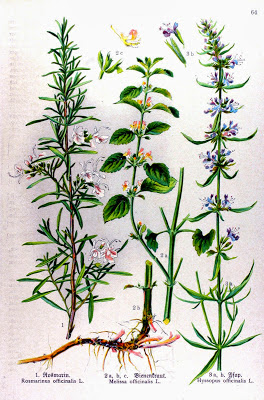Ease of Raising:
|
5/5 – Very Easy, plant and leave
|
Water:
|
1/5 – Minimal, weekly (especially in a container)
|
Sun:
|
5/5 – Full sun
|
Training:
|
1/5 – Minimal (only to shape)
|
Fertilise/Feeding:
|
1/5 – Minimal (at least once during the growing season)
|
Time to Harvest:
|
1/5 – Immediate (purchased a seedling) to Soon (from seed)
|
Frost Hardiness:
|
1/4 – Very Hardy (can’t take black frost)
|
Uses:
|
Culinary, Medicinal, Pollinator attractor & Predator
sheltering
|
Most Problematic
Nemesis:
|
None
|
Container Plant:
|
Yes (preferably grown in the garden rather than container)
|
 |
| Rosmarinus officinalis Köhler's Medizinal-Pflanzen in naturgetreuen Abbildungen mit kurz erläuterndem Texte 1887 Kurt Stubers Online Library |
No garden is complete without rosemary. It is one of the essential herbs for cooking and for aromatherapy. Rosemary is mainly used in savoury dishes, but has various applications such as complementing cocktails and desserts.
History
Rosemary is native to the Mediterranean and grows well near the sea. It soon became popular in Europe and is surrounded by many medieval legends. It was used for protection at weddings and diseases, but the most common non-culinary use for rosemary was to improve memory and alleviate headaches.
Science Stuff
Rosemary belongs to the aromatic herb family Lamiaceae, which includes just about every other herb imaginable, such as mint, oregano, marjoram, thyme, sage, savory, basil and lemon balm.
Most culinary varieties of rosemary belong to the same species, Rosemarinus officinalis. The varieties of rosemary are distinguished by their different leaves (light to dark green), different flower colours (pink, white, blue) and aromas.
Rosemary is generally purchased as a seedling, but can be raised from seed.
Rosemary is very easy to care for, it loves warm sunny areas. As with lavenders, rosemary requires good drainage and water-logging should be avoided (no water in the saucer). This is due to rosemary being fairly heat & drought resistant, I water mine every second day in the garden (whereas container planted rosemary should be watered even less). This make rosemary useful as an ‘ornamental’ plant in the garden, where it is hot and dry – given that it easily gets up to 30oC here - the rosemary/lavenders are standing strong whilst the other plants suffer J.
Rosemary does not appreciate temperatures below -12oC and does not like snow – so for those who have this in winter, simply dig out the rosemary and keep the herb indoors until it can be planted outside again (Ina Garten, chef and owner of “The Barefoot Contessa” does this every year with her rosemary). This ensures that you have rosemary all year round, as it is evergreen.
 |
| Rosmarinus officinalis Köhler's Medizinal-Pflanzen in naturgetreuen Abbildungen mit kurz erläuterndem Texte 1887 Kurt Stubers Online Library |
I keep my rosemary shrub in check with regular snipping of the top-most part of the growing sprigs (10cm at the top is cut, once every 1-2 months). This is mostly due to me having limited space, but you can give it a good pruning after flowering in summer (reduce the branches by half). This will keep your rosemary bushy and supply you with new growth for cooking. Pruning is a good thing to do with all you shrubs and trees, especially rosemary, sage and mints, as they become scraggly easily with long bare branches and few leaves at the tips.
Other Tips
Rosemary is evergreen, so you really do not need to have copious amounts of dried rosemary as you will always have fresh ones. Give pruning cut-offs to friends and family
Harvesting & Storing
Rosemary is harvested throughout the year. Some can be dried, if you require a milder taste for certain dishes. Simple pick the leaves, rinse them off and dry on a paper towel inside for about a week. Store the leaves in glass jars.
 |
| Rosemary Rosmarinus officinalis |
You can also make rosemary flavoured oils. The leaves are heated in oil (the oil must not boil- that destroys the rosemary essential oils) until smoke comes off the oil. The rosemary leaves are strained while the warm oil is poured into a glass bottle. Unfortunately you cannot leave the rosemary sprigs in the bottle with the oil as it will start to go mouldy (yes right in the oil!) – leaves and other ingredients (peppers …) are left in vinegar bottles as the vinegar acts as a natural preservative, which make them look so pretty as well
Seed Saving & Propagation
Rosemary seeds can be saved once the flowers have turned brown. The seeds are labelled and stored in a glass jar. The seeds should remain viable for about 1-2 years. The seeds are sowed in soil that has heated to 20oC and will take 2-3 weeks to germinate.
My Rosemary
Tuscan Rosemary: This is the Tuscan Blue variety of Rosemary. I find it a lot more robust than the ‘usual’ rosemary and it grows a lot better in the garden. It has darker green leaves and a deeper earthy flavour, which I prefer to the normal rosemary.
2.JPG) |
| Tuscan Rosemary Rosmarinus officinalis |
______________________________________________________________________________
Please share with fellow gardening enthusiasts via the various sharing buttons at the end of posts/pages! Else you can vote for posts through the Google reactions bar at the end of articles. To stay up to date I have provided several reader and social networking platforms with which to subscribe: Twitter, Pinterest, RSS Feed Reader or Email/Follow directly using the Blog Followers widget on the left hand side toolbar. Thank you for reading and please feel free to ask if questions arise - I appreciate comments and ideas too! 😆
_________________________________________________________________________________
.JPG)
